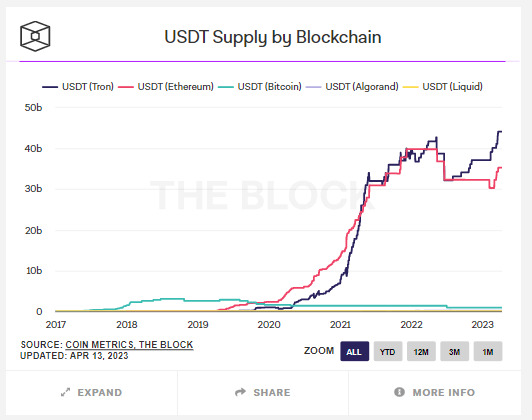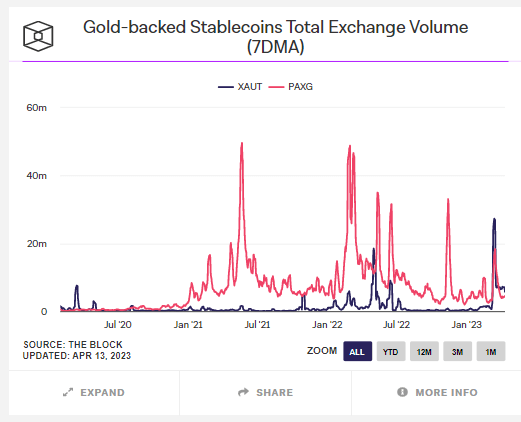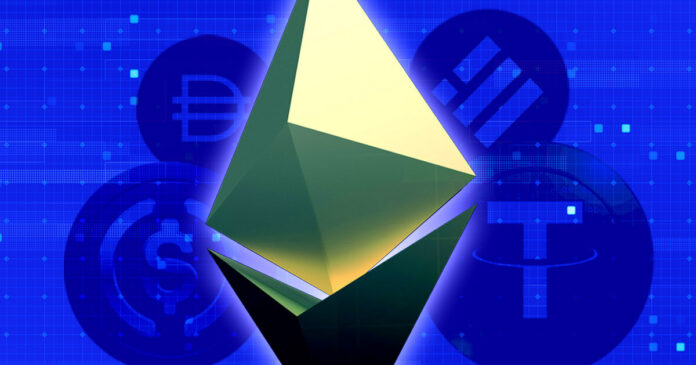After Terra UST’s de-peg in May 2021 prompted fears over the safety of stablecoins, crypto advocates pointed out fundamental differences between algorithmic stablecoins and fiat-backed stablecoins, inferring the latter to be more resilient.
However, that claim was tested recently over two different events. In March, USDC de-pegged from its dollar price, falling as low as $0.8218, as it emerged parent company Circle held $3.3 billion of deposits with the now-bankrupt Silicon Valley Bank (SVB).
Likewise, in February, the New York Department of Financial Services (NYDFS) ordered Paxos to stop the issuance of its dollar-backed BUSD stablecoin as it investigated allegations of securities violations. BUSD’s market cap valuation has been spiraling downwards since.
Glassnode data analyzed by CryptoSlate uncovered that stablecoin activity on Ethereum is trending down, with glimpses that TRON may emerge as the winner in this changing landscape.
In addition, a new narrative appears to be emerging in gold-backed stablecoins.
Stablecoin Active Addresses on Ethereum plunge
An address is considered active when involved in a transaction as either a sender or receiver of funds. The number of Active Addresses is a measure of usage and an indicator of a particular cryptocurrency’s popularity.
The chart below shows Active Addresses for USDT, USDC, BUSD, and DAI operating on the Ethereum blockchain. All four have recorded a sharp downturn in recent weeks.
Since 2018, stablecoin market leader Tether (USDT) has seen a rise that peaked at 150,000 in June 2020. The ensuing downtrend bottomed at 40,000 by July 2022 – setting off a recovery that re-reached marginally above the previous peak at the start of this year.
Since then, USDT Active Addresses on Ethereum have sunk – with February onwards seeing an acceleration of that trend. Currently, the number of Active Addresses stands at 69,225.
Analysis of USDC Active Addresses shows a general uptrend since September 2020 – peaking at 60,000 around March. However, a significant drop-off followed, taking the current number of Active Addresses to 25,700.
Active Address data for DAI and BUSD is barely perceptible using the same scaling. However, DAI began dipping around March, leading to 2,700 Active Addresses at present. Likewise, BUSD Active Addresses fell to 857.
Transfer Volume
Transfer Volume refers to the amount of cryptocurrency moving from one address to another. Like Active Addresses, Transfer Volume can gauge usage and popularity.
Aggregate stablecoin Transfer Volume on Ethereum has now dipped to lows last seen in January 2021. The presence of lower highs since June 2022 suggests this is part of a general downtrend from before recent negative news to do with SVB and the NYFDS – possibly to do with the perceived narrative that all stablecoins are like Terra UST.
On the Ethereum blockchain, USDC Transfer Volume currently comes in at 7.033 billion vs. 3.858 billion for USDT.

TRON
Fears around the safety and security of USDC and BUSD triggered a rise in USDT’s market cap – indicating USDT is viewed by the market as more trustworthy than the other two, despite ongoing redemption controversies.
USDT is available on the Algorand, Avalanche, Ethereum, EOS, Liquid Network, Near, Omni, Polygon, Solana, Bitcoin Cash’s Standard Ledger Protocol, Statemine, Statemint, Tezos, and Tron blockchains.
The chart below shows USDT Supply on TRON outpacing Ethereum from August 2022 onwards – meaning users prefer to transact in USDT using TRON over Ethereum – likely due to the former being much cheaper to use.

Gold-backed stablecoins
Amid current macroeconomic conditions, the price of gold cracked $2,000/oz on March 20. Although this is below its $2,070/oz all-time high, the flip to “real assets” over “fake money” has analysts predicting further surges to come.
Being pegged to the price of gold, gold-backed stablecoins offer the best of both worlds in retaining the tradeability and portability of crypto with the backing of a physical commodity that has thousands of years of history.
The two most popular gold stablecoins by market cap are Paxos Gold (PAXG) and Tether Gold (XAUT).
The chart below shows the Total Exchange Volume for PAXG and XAUT over a 7-day moving average. The pattern for PAXG positively correlates with the price of gold – which hit its ATH in March 2022 – corresponding with a spike in PAXG’s Total Exchange Volume around the same time.
More recently, XAUT is emerging as the more dominant of the two in terms of Exchange Volume.
As gold continues gaining momentum, so too will the popularity of gold-backed stablecoins.

The post Research: TRON and gold-backed stablecoins poised for growth as Ethereum activity shrinks appeared first on CryptoSlate.
Credit: Source link






















 Bitcoin
Bitcoin  Ethereum
Ethereum  Tether
Tether  Solana
Solana  USDC
USDC  XRP
XRP  Lido Staked Ether
Lido Staked Ether  Toncoin
Toncoin  Dogecoin
Dogecoin  Cardano
Cardano  Shiba Inu
Shiba Inu  Avalanche
Avalanche  TRON
TRON  Wrapped Bitcoin
Wrapped Bitcoin  Polkadot
Polkadot  Bitcoin Cash
Bitcoin Cash  Chainlink
Chainlink  NEAR Protocol
NEAR Protocol  Polygon
Polygon  Litecoin
Litecoin  Fetch.ai
Fetch.ai  Uniswap
Uniswap  Internet Computer
Internet Computer  Dai
Dai  LEO Token
LEO Token  Render
Render  Ethereum Classic
Ethereum Classic  Hedera
Hedera  First Digital USD
First Digital USD  Aptos
Aptos  Pepe
Pepe  Cosmos Hub
Cosmos Hub  Cronos
Cronos  Mantle
Mantle  Filecoin
Filecoin  Wrapped eETH
Wrapped eETH  Immutable
Immutable  Stellar
Stellar  dogwifhat
dogwifhat  Stacks
Stacks  OKB
OKB  Renzo Restaked ETH
Renzo Restaked ETH  The Graph
The Graph  Optimism
Optimism  Arbitrum
Arbitrum  Arweave
Arweave  Bittensor
Bittensor 
